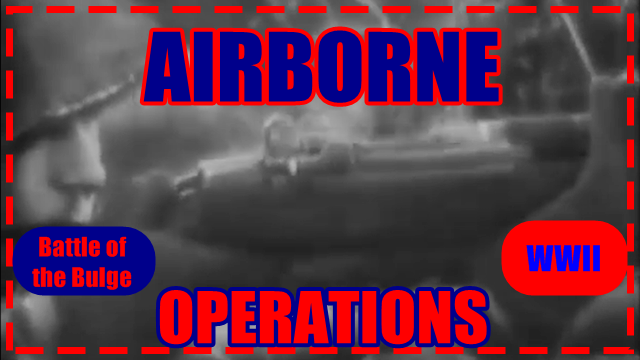
Watch real combat footage of Army units from the 101st and 82nd Airborne divisions in or near Bastogne fighting in the Battle of the Bulge during World War II.
SURROUNDED AT BASTOGNE
By 21 December the Germans had surrounded Bastogne, which was defended by the 101st Airborne Division, the all African American 969th Artillery Battalion, and Combat Command B of the 10th Armored Division. Conditions inside the perimeter were tough—most of the medical supplies and medical personnel had been captured. Food was scarce, and by 22 December artillery ammunition was restricted to 10 rounds per gun per day. The weather cleared the next day, however, and supplies (primarily ammunition) were dropped over four of the next five days.
Despite determined German attacks, however, the perimeter held. The German commander, Generalleutnant (Lt. Gen.) Heinrich Freiherr von Lüttwitz, requested Bastogne’s surrender. When Brig. Gen. Anthony McAuliffe, acting commander of the 101st, was told of the Nazi demand to surrender, in frustration he responded, “Nuts!” After turning to other pressing issues, his staff reminded him that they should reply to the German demand. One officer, Lt. Col. Harry Kinnard, noted that McAuliffe’s initial reply would be “tough to beat.” Thus McAuliffe wrote on the paper, which was typed up and delivered to the Germans, the line he made famous and a morale booster to his troops: “NUTS!” That reply had to be explained, both to the Germans and to non-American Allies.
Both 2nd Panzer and Panzer-Lehrdivision moved forward from Bastogne after 21 December, leaving only Panzer-Lehrdivision’s 901st Regiment to assist the 26th Volksgrenadier-Division in attempting to capture the crossroads. The 26th VG received one Panzergrenadier Regiment from the 15th Panzergrenadier Division on Christmas Eve for its main assault the next day. Because it lacked sufficient troops and those of the 26th VG Division were near exhaustion, the XLVII Panzerkorps concentrated its assault on several individual locations on the west side of the perimeter in sequence rather than launching one simultaneous attack on all sides. The assault, despite initial success by its tanks in penetrating the American line, was defeated and all the tanks destroyed. The next day, 26 December, the spearhead of Gen. Patton’s 4th Armored Division, supplemented by the 26th (Yankee) Infantry Division, broke through and opened a corridor to Bastogne.
BATTLE OF THE BULGE CASUALTIES
Casualty estimates for the battle vary widely. According to the U.S. Department of Defense, American forces suffered 89,500 casualties including 19,000 killed, 47,500 wounded and 23,000 missing. An official report by the United States Department of the Army lists 105,102 casualties, including 19,246 killed, 62,489 wounded, and 26,612 captured or missing. A preliminary Army report restricted to the First and Third U.S. Armies listed 75,000 casualties (8,400 killed, 46,000 wounded and 21,000 missing). The Battle of the Bulge was the bloodiest battle for U.S. forces in World War II. British casualties totaled 1,400 with 200 deaths. The German Armed Forces High Command’s official figure for all German losses on the Western Front during the period 16 December 1944 – 25 January 1945 was 81,834 German casualties, and other estimates range between 60,000 and 125,000. German historian Hermann Jung lists 67,675 casualties from 16 December 1944 to late January 1945 for the three German armies that participated in the offensive. The United States Army Center of Military History’s official numbers are 75,000 American casualties and 100,000 German casualties.